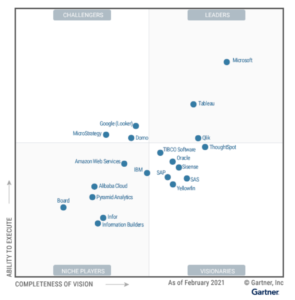
Augmented Analytics Is the New BI Battle Ground, Gartner Says

(Peshkova/Shutterstock)
Forget about nifty visualizations in business intelligence (BI) tools–everybody has those now, according to Gartner. The real action in the BI market is around augmented analytics, or how well the BI tools incorporate machine learning and AI. In the latest Gartner Magic Quadrant for analytics and BI tools, Microsoft is far and away the leader, followed by Tableau and Qlik.
“All vendors can build interactive key performance indicator (KPI) dashboards using common chart forms (bar/column, line/area, scatter, pie and geographic maps) and drawing on a wide range of data sources,” Gartner analysts write in the Magic Quadrant, which was published last week. “Differentiation has shifted to how well platforms support augmented analytics.
The augmentation comes in several forms, including ML- and AI-assisted data prep, query generation, and insight generation. Instead of existing in discrete parts of the analytics and ABI tools, these ML and AI capabilities are infused throughout the ABI (analytics and BI) products, Gartner says.
Microsoft owns the upper right portion of the Magic Quadrant–a position it has now held since 2016–and has a healthy lead over its nearest competitor, Tableau, which is owned by Salesforce. Qlik actually exceeds Tableau on the “completeness of vision” scale, but lacks the resources of Tableau/Salesforce (let alone Microsoft) and thus has lower “ability to execute” score.
Microsoft’s PowerBI continues to be a dominant force in the BI market, thanks in part to Microsoft’s huge Office 365 customer base and the linkage it has built between Office 365 and PowerBI. Most of the new ABI spending is happening in the cloud, and Microsoft is right there with cloud subscriptions for PowerBI, as well as a free desktop app and a server-based version (for the six or seven companies out there that still don’t believe in cloud).
“The Power BI cloud service is extremely rich in its capabilities, which include an enlarged set of augmented analytics and automated ML capabilities,” Gartner says. “AI-powered services, such as text, sentiment and image analytics, are available within Power BI Premium and draw on Azure capabilities.”
The only knock against PowerBI is the lack of functionality in the on-prem version, called Power BI Report Server. Gartner says it doesn’t include the same dashboarding, streaming analytics, natural language question and answer, augmentation, and alerting features available in the Azure version. There is also no cloud IaaS version of PowerBI, which means customers are locked into Azure (which of course is good for Microsoft, but bad for customers)
Tableau has always had a sleeker-than-average user interface for its BI product, and that continues to be the case, according to Gartner. “Although visual-based exploration is highly commoditized in today’s market, Tableau can still differentiate itself by offering an intuitive analytics experience with richer capabilities based on its patented VizQL engine,” the analysts write.
But more recently, Tableau has bolstered the flash with meat and potatoes features, like better data prep and data management capabilities. New data modeling features enable customers to compare data across multiple tables and different detail levels, and there’s also a new data catalog. The folks in Stamford, Connecticut are looking forward to the integration of Salesforce Einstein Analytics with Tableau, which is slated to occur in March.
Knocks against Tableau include a lack of a cloud-native architecture (i.e. a lack of support for containerized deployments), which prevents on-prem customers to embrace the cloud’s full benefits, according to Gartner. Premium pricing and integration issues are other challenges mentioned by Gartner.
Qlik offers a strong vision for augmented analytics, according to Gartner. It bolsters its 25-year-old Associative Engine with a Cognitive Engine that adds AI/ML-driven functionality to the product. What’s more, it offers relative freedom of deployment options, with support for multiple clouds, a SaaS offering from Qlik, and an on-premise option.
Qlik supports multiple personas, providing both visual analytic/self-service capabilities as well as support for developers. The company’s data catalog provides integrated governance, but the Data Integration Platform (formerly Attunity) is separate. Gartner appreciates the Qlik Data Literacy program, as well portals to help executives understand use cases and explore analytics modernization. Knocks against Qlik include pricing complexity, low market momentum, and a lack of product cohesiveness.
Aside from these three vendors, there is a lot of competition, with 20 vendors making the Magic Quadrant cut. The market is big, with established vendors like SAS, Oracle, SAP, and TIBCO Software, as well as newcomers like ThoughtSpot, Sisense, and Yellowfin occupying the Visionaries quadrant. The Challengers quadrant is relatively sparse, with newcomers Looker (now part of Google Cloud) and Domo leading MicroStrategy. The Niche Players quadrant is very hectic, with IBM, AWS, Alibaba Cloud, Pyramid Analytics, Infor, Information Builders, and Board looking to differentiate themselves.
All told, the BI market accounted for $6 billion in spending in 2020, a 19% boost over the previous year. As previously stated, the bulk of the new spending is occurring on the cloud. While overall spending is increasingly slower than it did a decade ago, the number of folks actually using these products has exploded, with millions now using them on a regular basis, according to Gartner.
No vendor has benefited more from these cloud dynamics than Microsoft, thanks to aggressive pricing for the PowerBI cloud service and bundling through Office 365. The growing integration between Power BI and Microsoft Teams will further fuel growth as long as remote work remains a driving factor in the workplace, Gartner says.
In the long run, the BI platforms are on a collision course with data science and machine learning platforms, according to Gartner.
“ABI platforms increasingly include functionality to perform augmented data science and ML tasks, with predictive models being executed ‘behind the scenes, and insights ‘surfaced’ within the ABI process flow,” the analyst group says. “Data science and ML platforms, for their part, increasingly feature enhanced data transformation and discovery capabilities, such as data visualization, that are traditionally more characteristic of ABI platforms. Currently, the two remain discrete markets with different buyers, but that situation is likely to change.”
Related Items:
ML and BI Are Coming Together, Gartner Says
Gartner: Augmented Analytics Ready for Prime Time
Microsoft Surges in Gartner Quadrant with Power BI































